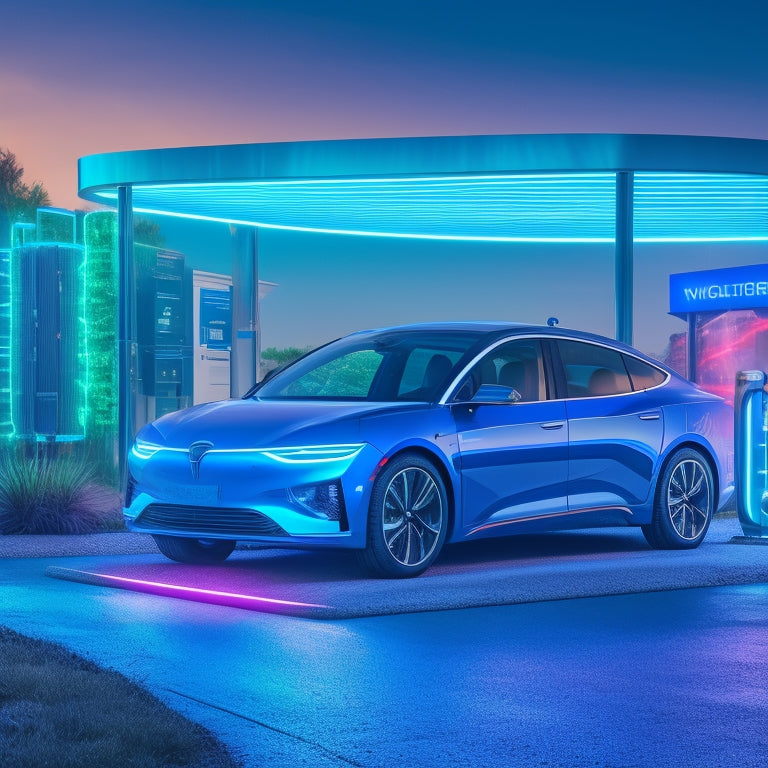
Mastering Electric Vehicle Charging: A Comprehensive Guide
Share
Mastering electric vehicle (EV) charging requires a thorough understanding of charging methods, finding charging stations, and optimizing charging habits. There are three primary charging methods: Level 1, Level 2, and Quick Charging, each with varying speeds and conveniences. Effective charging habits involve charging during off-peak hours, topping off the battery whenever possible, and utilizing energy-efficient modes. Additionally, finding charging stations is essential, with many located in urban centers and accessible through charging apps and navigation systems. By grasping these key concepts, EV owners can minimize range anxiety, reduce energy consumption, and maximize their overall ownership experience, and further exploration of these topics will uncover even more benefits.
Key Takeaways
• Level 1 charging is the most convenient method, using standard household outlets, but is the slowest method.
• Level 2 charging takes 4-8 hours for a full charge and can be done at commercial lots or with home installation.
• Charging stations are commonly found in urban centers, such as malls, grocery stores, and office buildings, and can be located using charging apps.
• Charging during off-peak hours and using energy-efficient modes can help reduce energy consumption and costs.
• Optimizing charging habits, such as topping off the battery whenever possible, can help reduce range anxiety and minimize costs.
Understanding Charging Methods
Electric vehicle (EV) owners have three primary charging methods to replenish their vehicle's battery: Level 1, Level 2, and Quick Charging, each varying in speed, convenience, and accessibility.
Level 1 charging, the slowest method, uses a standard household outlet and is the most convenient, but requires the longest time to recharge.
Level 2 charging speeds up the process, taking 4-8 hours to reach the best range, and can be done at commercial parking lots or with professional installation at home.
Quick Charging, the fastest method, is ideal for long trips or when in a hurry, but requires a dedicated station and subscription or payment.
Understanding the benefits of each method, such as Level 1's convenience and Quick Charging's speed, helps EV owners optimize their charging experience.
Finding Charging Stations
Conveniently situated in urban centers, charging stations are increasingly accessible, with many malls, grocery stores, and office buildings designating parking spaces with integrated charging facilities.
Locating stations is made easier through the use of charging apps, which provide real-time information on station availability and location.
Urban charging infrastructure is well-established, but rural access is improving, with networks like EVgo, Electrify America, and ChargePoint expanding their reach.
Many electric vehicles also have charging locations programmed in their navigation systems, making it easy to find a charging stop on the go.
Optimizing Charging Habits
To maximize the efficiency and cost-effectiveness of electric vehicle ownership, it is important to develop optimized charging habits that take into account factors such as timing, location, and frequency of charging. By adopting smart charging practices, EV owners can reduce their energy consumption, lower their electricity bills, and minimize range anxiety.
Here are three essential tips to optimize your charging habits:
-
Charge during off-peak hours: Take advantage of lower electricity rates and reduce strain on the grid by charging your EV during non-peak hours, such as overnight.
-
Top off whenever possible: Reduce range anxiety by topping off your EV's battery whenever you have access to convenient charging, such as at work or while shopping.
-
Use energy-efficient charging modes: Utilize your EV's built-in energy-saving features, such as eco-mode, to minimize energy consumption and maximize cost savings.
Frequently Asked Questions
Can I Charge My Electric Vehicle in the Rain or Wet Conditions?
Electric vehicles can be safely charged in rainy or wet conditions, thanks to water-resistant connectors and safety precautions built into charging systems, ensuring a secure and reliable charging experience.
How Often Should I Update My Vehicle's Charging Software?
Consistently updating your electric vehicle's charging software guarantees seamless functionality and optimizes performance; install firmware updates and software patches as soon as they become available to secure efficient and reliable charging experiences.
Do Electric Vehicles Have a Limited Number of Charge Cycles?
Electric vehicles do not have a limited number of charge cycles; however, battery health and charge capacity may degrade over time, affecting overall performance, with careful maintenance and ideal charging practices helping to minimize this impact.
Can I Use Any Charging Cable or Adapter With My Vehicle?
When choosing a charging cable or adapter, verify compatibility with your vehicle's specifications to avoid safety risks. Refer to the manufacturer's guidelines for approved accessories, and prioritize cable compatibility and adapter safety to guarantee efficient and secure charging.
Will Fast Charging Reduce My Electric Vehicle's Battery Life?
Efficient charging can impact battery health, but modern EVs are designed to mitigate this effect. Ideal charging patterns, such as avoiding frequent deep discharging and minimizing high-temperature charging, help preserve battery health and extend lifespan.
Related Posts
-

How to Upgrade Your Home With Geothermal Innovations
You're now on the cusp of utilizing the Earth's natural thermal energy to revolutionize your home's heating and cooli...
-

3 Green HVAC Filters for Solar-Powered Homes
When outfitting your solar-powered home with an HVAC system, you'll want to choose filters that align with your commi...
-

Green Deck Options: Earth-Conscious Choices for Your Home
You're looking for a deck that not only enhances your home's exterior but also aligns with your eco-friendly values. ...


